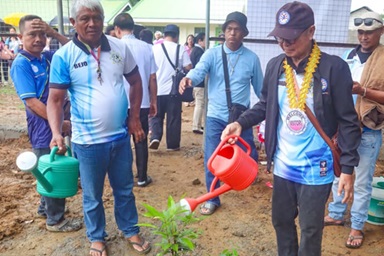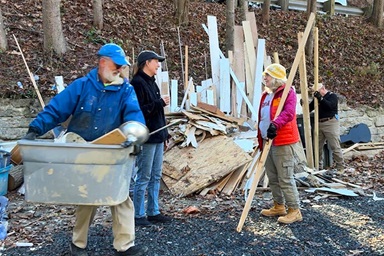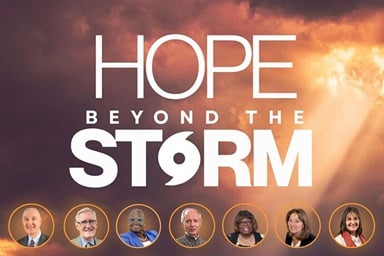Five years after Hurricane Sandy roared up the east coast, United Methodists leaders in recovery efforts recognized rebuilding efforts — but also expressed concern for the work that still needs to be done.
The storm killed more than 70 people and caused damage totaling more than $50 billion. The surge hit New York City on Oct. 29, 2012, flooding streets, tunnels and subway lines and cutting power in and around the city.
“Long term recovery is just that — it’s long, and it wears on people,” said the Rev. Tom Vencuss, disaster coordinator for the New York Conference.

Bishop John Schol of the Greater New Jersey Annual Conference (left) and N.J. Gov. Chris Christie at a Day of Prayer church service Oct. 29, celebrating the accomplishments of A Future With Hope at Andrew’s United Methodist Church in Toms River, N.J. Photo courtesy of A Future With Hope.
Churches in the Greater New Jersey Conference commemorated the anniversary with a Day of Prayer on Oct. 29 at St. Andrews United Methodist in Toms River. Bishop John Schol and New Jersey Gov. Chris Christie were on hand for a special worship service to mark the occasion. And on the anniversary weekend, another storm left 1 million people without power.
Bobbie Ridgely, executive director of A Future With Hope, the Greater New Jersey Conference’s Sandy recovery effort, said people are surprised to learn recovery is still underway five years later.
“There’s a tendency to think that it’ll be all taken care of in six months, but it’s a much longer process to get fully recovered,” Ridgely said.
The United Methodist Committee on Relief provided financial assistance through the conferences in the areas most affected: more than $3.1 million to the Greater New Jersey conference, almost $4 million to the New York conference, and $500,000 to the Peninsula-Delaware conference — as well as support, expertise and training.
In the Peninsula-Delaware Conference, recovery efforts focused on Somerset County, Maryland, where volunteers rebuilt more than 200 homes destroyed by Sandy.
In New Jersey, A Future With Hope is one of the last remaining nonprofit organizations on the ground assisting with long-term recovery efforts. In the past five years, it has helped 461 families, completed construction on 260 homes, and coordinated some 12,173 volunteers, including United Methodists as well as Lutherans, Episcopalians, Mennonites and many others from 46 states in the U.S. and from Canada.
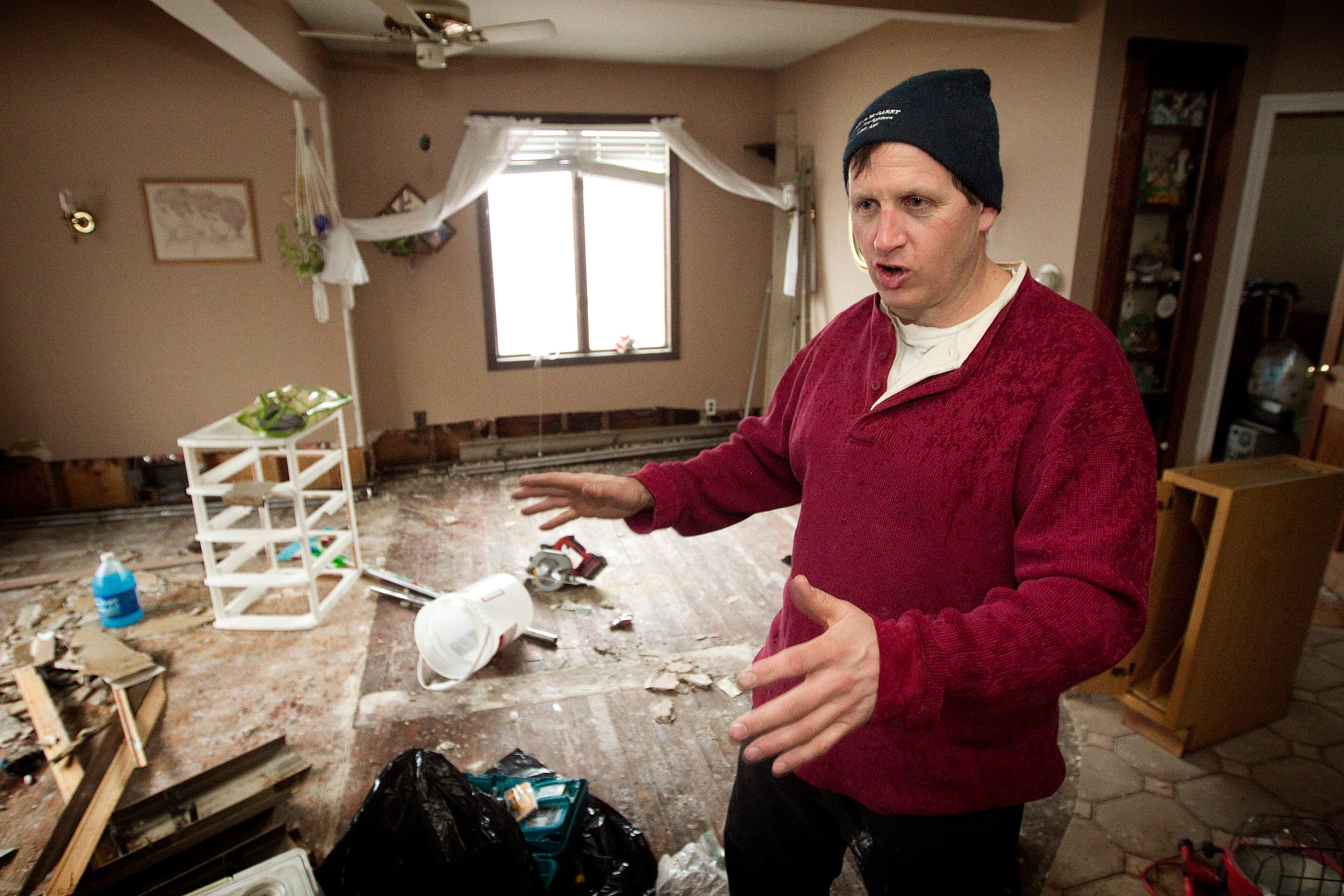
As the storm’s first anniversary approached, Peter Vasquenz describes damage to his mother's home in the Staten Island borough of New York following Hurricane Sandy in November 2012. Vasquenz, a firefighter in Brooklyn, had been ripping out waterlogged drywall and flooring. File photo by Mike DuBose, UMNS.
Started by the Greater New Jersey Conference, A Future With Hope also receives support from the Robin Hood Foundation, the American Red Cross, the Hurricane Sandy NJ Relief Fund and UMCOR, among others.
“We’ve been getting homeowners back to safe, sanitary and secure homes, and we feel good about the progress we’ve made,” said Ridgely. “But there are still an estimated 2,000 families in New Jersey that have not yet finished recovery.”
Some of the challenges prolonging the process: Scammers and unscrupulous contractors who took money from families, then disappeared; the complex process of coordinating support from insurance companies, government agencies and non-profits; building codes and permitting processes that vary from town to town.
“We’ve worked in 40 different municipalities, and each has a little bit different take on how they want things done,” said Ridgely.
With help from A Future With Hope, Frank and MaryEllen Azack of Toms River, New Jersey, just received their Certificate of Occupancy on Sept. 21, 2017. For nearly five years, Frank lived in a nearby apartment while devoting full-time to recovery. MaryEllen, who has multiple sclerosis, stayed with her mother in Kearny, about an hour away, because she was unable to navigate the stairs in the apartment.
“It’s been a long battle, but we’re finally home,” Frank Azack said.
Now reunited, the couple sat in the bright, sunny living room in their home as they recounted their story of returning after the storm to their neighborhood, which looked like a war zone. They told of standing in line for hours just to apply for FEMA benefits or to get a hot meal at McDonalds; of discovering that, even with insurance, recovery was costly, complicated, arduous and slow.
Recovering from Sandy
Local United Methodists have helped for five years in the areas hard-hit by Sandy, but recovery assistance also has come from volunteer teams around the U.S. and from donors across the connection.
To learn more, see the photos and read the stories at Superstorm Sandy: The church responds
Without help from energetic volunteer crews and case managers from A Future With Hope, the Azacks say they’d likely be homeless.
“Now we feel like our future does have hope, because we hooked up with this wonderful group of people,” MaryEllen Azack said. “Thank you, thank you, thank you.”
The New York Conference’s Disaster Recovery Ministries has assisted more than 1,550 families in relief and recovery and provided some $7.7 million in direct client services, including volunteer labor, case management and goods and materials to clients. The conference also coordinated Volunteers in Mission relief and recovery teams and provided disaster case management as well as emotional and spiritual care. UMCOR, the American Red Cross, churches and other conferences also have supported the efforts.
With funds almost exhausted and the stream of volunteers drying up, the conference will conclude its recovery program by end of year. But Vencuss says there are still families waiting to return to their homes.
“We’re at the point where people start asking, ‘When will it end?’” he said. “That’s why we try to stay as long as we can.”
Vencuss cites the situation facing Tom Kurianski, a Sandy victim who lives in Lindenhurst on Long Island. Kurianski has flood insurance, and he works in building design, so he could handle some of the restoration work himself. But this past summer he moved back to an apartment while awaiting crews to elevate his home — a necessary step to keep flood insurance rates reasonable and to eventually be able to sell his home. Work still hasn’t begun.
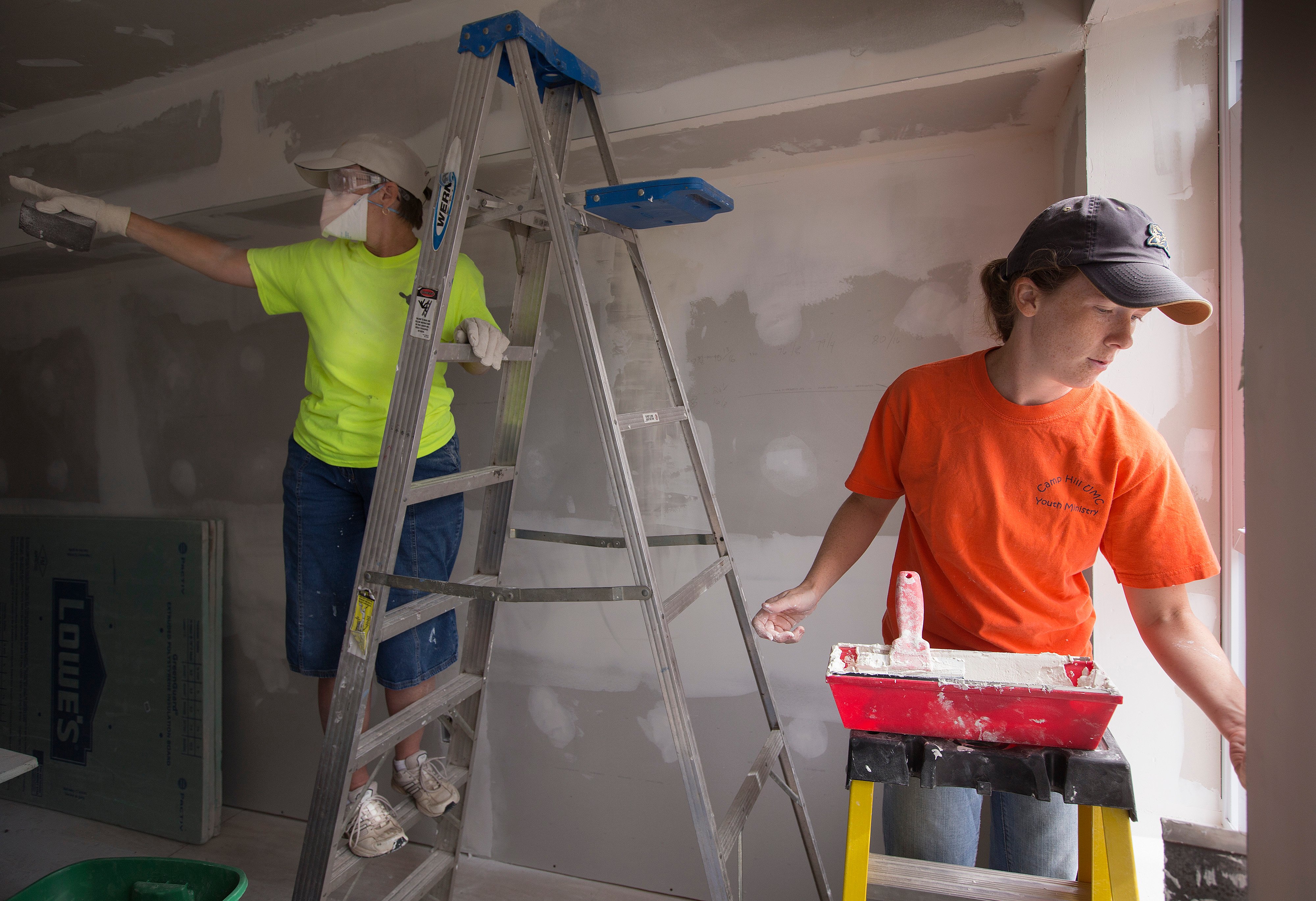
Volunteers Kayt Hughes (right) and Janice Bosley of Stewartstown (Pa.) United Methodist Church finish drywall in October 2013 at a home in Atlantic City, N.J., that was damaged by Hurricane Sandy. They were part of a team from the volunteer ministry Servants, Inc., and working through A Future With Hope, which has led long-term recovery efforts for the Greater New Jersey Conference over the past five years. File photo by Mike DuBose, UMNS.
Kurianski’s tale is a litany of one frustrating setback after another — building codes that changed during the construction process, endless paperwork, miscommunication between contractors and government agencies. But his voice brightens as he describes the volunteer teams sent by the New York Conference that tackled the sheetrock and painting in his small cottage.
“They’d bring 12 to 15 people at a time, and they’d really move things along,” he said. “If I’d done it myself, it would’ve taken months. The unselfishness was just amazing.”
Vencuss says he’s been inspired, personally, by the resiliency of people like Kurianski.
“The people we met were so positive and appreciative,” he said. “We’d introduce a client to a team from California, or Georgia, and they’d say, ‘They came all the way from there to help me for a week?’”
Ridgely sees blessings, too. Recovery projects are a testament to the power of the United Methodist connectional system, she said, not only in getting things done but also in serving as a witness. She shared how one Monmouth County resident was affected just by the presence of volunteers at a host site next door, even though they weren’t working directly with her.
The resident told Ridgely: “To see the volunteers going in and out of the church host site and working throughout the community — as a Sandy survivor, that has restored my hope.”
Vencuss agreed.
“It’s about relationships and a ministry of care. It’s showing up and being there and letting people know they’re not alone,” Vencuss said.
Jacobs is a freelance writer living in Plano, Texas.
News media contact: Vicki Brown, Nashville, Tennessee, (615) 742-5470or [email protected]. To get more United Methodist news, subscribe to the free Daily or Weekly Digests
Like what you're reading? Support the ministry of UM News! Your support ensures the latest denominational news, dynamic stories and informative articles will continue to connect our global community. Make a tax-deductible donation at ResourceUMC.org/GiveUMCom.





